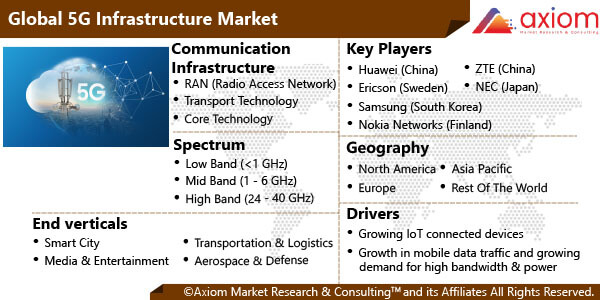5G is termed as the 5th generation technology standard for the broadband cellular networks. This network would be acting as the successors to the 4G networks, which currently provide network connectivity to most of the cell phones.
The 5G wireless technology is designed to deliver multi – Gbps data speed, ultra-low – latency, more reliable connection, massive network capacity, and a more customised user experience
5G Infrastructure Market Dynamics
The 5G infrastructure market is basically driven due to the emerging technologies, like virtual reality, augmented reality, applications of artificial intelligence in almost all the sectors, which require high speed network connections. 5G networking offers functionalities like virtualization, network slicing, which would help the people by providing user-specific (customized) networks.
Also, the growing need for ultra-low latency significantly drives the demand for 5G infrastructure.
COVID 19 Impact on Global 5G Infrastructure Market
The globally spread COVID-19 has changed the dynamic of many countries and their working cultures. As far as the 5G infrastructure market is concerned, the pandemic has simply halted the progression of it. The various steps and measures taken in order to fight the COVID virus spread, have overall affected the finalization of 5G infrastructure standards.
But, as the world is moving ahead slowly from the downfall of economy, various vendors of the 5G infrastructure are focussing on rolling out 5G network in the upcoming year.
5G Infrastructure Market Segmental Overview
The report analyses the 5G infrastructure market based on the type of communication infrastructure, spectrum band, end verticals and geography. The communication infrastructure further divides the market into radio access network, transport technology, and the core technology. On the basis of spectrum band, the market is classified into low band, mid – band, and high band spectrums respectively. Whereas, based on end verticals, the market is bifurcated into smart city, media & entertainment, transportation & logistics, aerospace & defence and energy & utilities.
5G Infrastructure Market by Communication Infrastructure
Based on the communication infrastructure, the 5G infrastructure market is segmented into radio access network, transport technology, and core technology. The radio access network (RAN) infrastructure is further segmented into C – RAN/V – RAN, small cell, and massive MIMO. The transport technology infrastructure is further classified into software – defined networking (SDN), and network slicing. And, the core technology infrastructure is further classified into networking function virtualization, and mobile edge computing.
For any smart phone to connect to a network, it first needs to connect through a radio access network (RAN), which use the radio transceivers to connect phones to the cloud. Hence, a RAN provides radio access to coordinate network resources across wireless devices, which connect to cellular network via LTE or other connections. The silicon chips in the core network and the user device, helps in the functionality of the RAN.
5G Infrastructure Market by Spectrum
Based on the spectrum band, the 5G infrastructure market is divided into low band, a spectrum of <1 GHz, which provides the consumers with a broad coverage area along with good building penetration; mid band, a spectrum between 1 GHz & 6 GHz, which provides faster throughput and lower latency, as compared to the low – band spectrum; and high band, a spectrum widely used for the 5G connections, sometimes also referred as mmWave, it enables 10 times of Gbps range at even lower latency.
5G Infrastructure Market by End – Verticals
On the basis of the verticals, the 5G infrastructure market is classified into smart city, media & entertainment, transportation & logistics, aerospace & defence, energy & utilities. The smart cities, which are viewed as the connected ecosystems, are known to be dominating the market share due to the maximum use of 5G network in various technologies like, connecting vehicles, connecting health, connecting workplace, public safety, utility governance, etc.
5G Infrastructure Market by Geography
Geographically, the 5G infrastructure market is studied across the countries of key regions such as, North America, Europe, Asia Pacific and rest of the world regions which includes Latin America, and Middle East &Africa.
It is expected that the Asia Pacific region could dominate the market, owing to the presence of several 5G and communication service providers over that region.
5G Infrastructure Market Key Players
Some of the major players operating in this market include Huawei (China), Ericson (Sweden), Samsung (South Korea), Nokia Networks (Finland), ZTE (China), NEC (Japan), CISCO (US), CommScope (US), Comba Telecom Systems (Hong Kong), Alpha Networks (Taiwan), Siklu Communication (Israel), Mavenir (US), SK Telecom (South Korea), Vmware Inc (US), T - Mobile (US), among many others.











